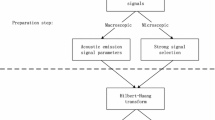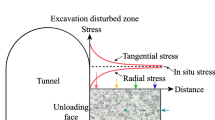Abstract
The parameterm in Ishimoto-Iida's relation was investigated for acoustic emissions (AEs) occurring in rock samples under uniaxial compression. In the experiment, we found: 1) The large AEs are counted without serious error but the number of small AEs is systematically underestimated at high AE rates, 2) the frequency distribution of maximum AE amplitudes becomes nonlinear in logarithmic scale with increasing AE rate, and 3) there exists a strong negative correlation betweenm-value and AE rate. The miscount of small AEs was interpreted as due to overlap of the large and small AEs. We call the miscount “masking effect”. A statistical analysis based on the masking effect showed that them-value decreases more effectively as the AE rate increases, and thus the masking effect is a possible origin both for the nonlinear frequency distribution of maximum AE amplitudes and for the negative correlation ofm-value with AE rate. We emphasize that one should be careful of the masking effect to examine correctly the change, ofm-value. In order to eliminate the masking effect, AEs should be measured by a measurement system with low sensitivity. Even if the masking effect is eliminated, them-value decreases before the main fracture of a rock sample. Them-value is a key parameter to predict the main fracture.
Similar content being viewed by others
References
Aki, K. (1965),Maximum likelihood estimate of b in the formula log N=a-bM and its confidence limits. Bull. Earthq. Res. Inst.43, 237–238.
Asada, T., Suzuki, Z., andTomoda, Y. (1950),On energy and frequency of earthquakes, J. Seism. Soc. Japan3, 11–15 (in Japanese).
Brace, W. F., Paulding, B. W., andScholz, C. H. (1966).Dilatancy in the fracture of crystalline rock. J. Geophys. Res.71, 3939–3953.
Hamada, K. (1968),Ultra micro-earthquakes in the area around Matsushiro. Bull. Earthq. Res. Inst.46, 271–318.
Hamaguchi, H. andHasegawa, A. (1970a),An investigation on the aftershocks of the Tokachi-oki earthquake of 1968 (1)Statistical study on magnitude distribution. Sci. Rep. Tohoku Univ. Ser. 5, Geophysics20, 85–105.
Hamaguchi, H. andHasegawa, A. (1970b),An investigation on the aftershocks of the Tokachi-oki earthquake of 1968, (2)Statistical study on time distribution. Sci. Rep. Tohoku Univ. Ser. 5, Geophysics20, 119–133.
Hasegawa, A. andHamaguchi, H. (1970),On the masking effect by the successive occurrence of earthquakes on time interval distribution. Sci. Rep. Tohoku Univ. Ser. 5, Geophysics20, 135–143.
Hasegawa, A. andHamaguchi, H. (1972),The masking effect on magnitude distribution by the successive occurrence of earthquakes. Sci. Rep. Tohoku Univ. Ser. 5, Geophysics21, 51–60.
Hirata, T., Nishizawa, O., Sato, T., andKusunose, K. (1986),B-value and creep test of rock, Program and Abstract Seism. Soc. Japan1, pp. 222 (in Japanese).
Imoto, S. (1984),Temporal change in the magnitude-frequency relation for the January 1983 Izu earthquake swarm, Japan. J. Seism. Soc. Japan37, 13–22 (in Japanese).
Kurita, K., Nishizawa, O., andFujii, N. (1978),Frequency distribution of the maximum amplitudes of acoustic emissions in creep test. Abstract Seism. Soc. Japan 2, pp. 101.
Lockner, D. A. andByerlee, J. D. (1977),Acoustic emission and creep in rock at high confining pressure and differential stress. Bull. Seism. Soc. Am.47, 247–258.
Lockner, D. A. andByerlee, J. D. (1978),Velocity anomalies: An alternative explanation based on data from laboratory experiments. PAGEOPH116, 765–772.
Mogi, K. (1962a),Study of the elastic shocks caused by the fracture of heterogeneous materials and its relation to earthquake phenomena. Bull. Earthq. Res. Inst.40, 125–173.
Mogi, K. (1962b),Magnitude-frequency relation for elastic shocks accompanying fractures of various materials and some related problems in earthquakes (first paper). Bull. Earthq. Res. Inst.40, 831–853.
Mogi, K. (1962c),The fracture of a semi-infinite body caused by an inner stress origin and its relation to earthquake phenomena (first paper). Bull. Earthq. Res. Inst.40, 815–829.
Mogi, K. (1963),The fracture of a semi-infinite body caused by an inner origin and its relation to earthquake phenomena (second paper)—The cause of the materials having some heterogeneous structures. Bull. Earthq. Res. Inst.41, 595–641.
Mogi, K.,Jisin Earthquake (Univ. Tokyo Press, Tokyo 1981), pp. 165.
Muramatu, I. (1964),On the equation to define the earthquake magnitude. J. Seism. Soc. Japan17, 210–221 (in Japanese).
Oda, H., Suzuki, I., andSeya, K. (1984),Application, of the Dugdale crack model to the stress-strain relations and bulk moduli of a granite. Tectonophysics110, 297–315.
Oda, H., Koami, H., andSeya, K. (1985),Quantification of stress heterogeneity in stressed rock. J. Seism. Soc. Japan38, 331–341 (in Japanese).
Oomori, F. (1884),On the aftershocks of earthquake. J. Coll. Sci. Imp. Univ. Tokyo7, 111–200.
Sano, O., Terada, M., andEhara, S. (1982),A study on the time-dependent microfracturings and strength of Oshima granite. Tectonophysics84, 343–362.
Scholz, C. H. (1968a),The frequency-magnitude relation of microfracturing in rock and its relation to eqrthquake. Bull. Seism. Soc. Am.58, 399–415.
Scholz, C. H. (1968b),Microfracturing and the inelastic deformation of rock in compression. J. Geophys. Res.73, 1417–1432.
Solov'ev, S. L. (1965),Seismicity of Sakhalin. Bull. Earthq. Res. Inst.43, 95–102.
Utsu, T. (1970),Aftershocks and earthquake statistics (II)—Further investigation of aftershocks and other earthquake sequences based on a new classification of earthquake sequences. J. Fac. Sci. Hokkaido Univ. Ser. VII, GeophysicsIII, 197–266.
Utsu, T. (1965),A method for determining the value of b in a formula log n=a-bM showing the magnitude-frequency relation for earthquake. Geophys. Bull. Hokkaido Univ.13, 99–103 (in Japanese).
Weeks, J. D., Lockner, D. A., andByerlee, J. D. (1978),Change in b-value during movement on cut surface in granite. Bull. Seism. Soc. Am.68, 333–341.
Yamamoto, K., Kusunose, K., andHirasawa, T. (1977),Frequency distribution of microfractures in rock sample under cyclic loading test. J. Seism. Soc. Japan30, 477–486 (in Japanese).
Author information
Authors and Affiliations
Rights and permissions
About this article
Cite this article
Oda, H., Koami, H. & Seya, K. Effect of occurrence rate of acoustic emissions on their statistical behavior. PAGEOPH 130, 5–29 (1989). https://doi.org/10.1007/BF00877734
Received:
Revised:
Accepted:
Issue Date:
DOI: https://doi.org/10.1007/BF00877734




